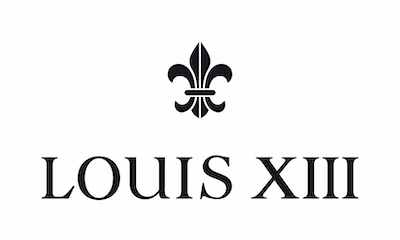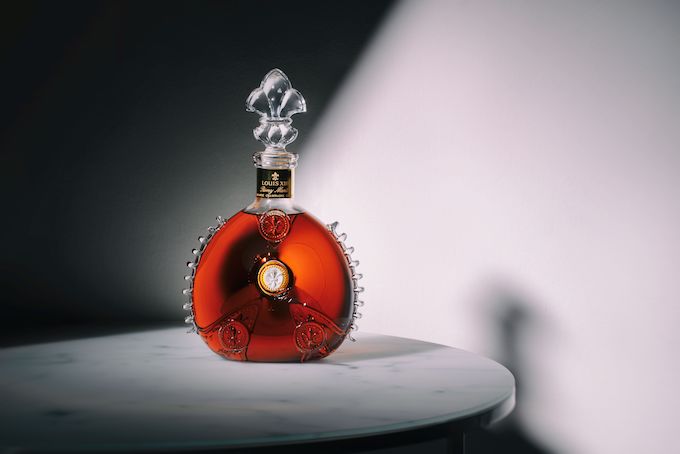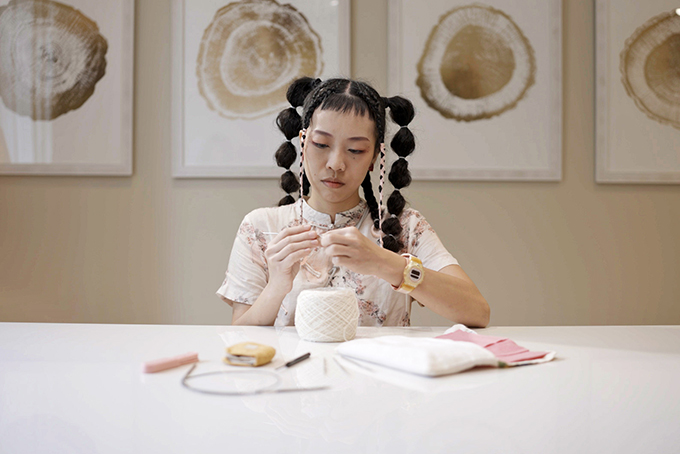In a grand artistic experiment, LOUIS XIII Cognac and Kelly Limerick capture the essence of time
6 October 2023
Crochet artist Kelly Limerick and luxury cognac house LOUIS XIII have found a natural partnership led by the shared secret ingredient behind their respective crafts. Here, she reveals the inspiration behind a monumental art piece crafted in collaboration with LOUIS XIII, spurred by the idea of transcending time
In partnership with

Crochet artist Kelly Lim has spent the last few months unravelling her own artwork over and over again. “I always say that your best work as an artist is the next one. You should never be too precious about what you have already made,” she says.
Still, taking apart a piece of crochet that took days to construct only to put it back together in another configuration feels particularly arduous. It takes a long time to create a piece of crochet art—even for Lim, who has been practising the craft since she was seven years old.
Better known as Kelly Limerick, Lim is one of Asia’s most prominent crochet artists, lauded for her reinvigoration of a traditional craft with contemporary explorations and lines of questioning. Her work—ranging from amorphous soft sculptures and intricate lattice work to full-scale installations constructed out of yarn—is instantly recognisable.
“I love playing with time as a storytelling device,” says Lim. “Crochet, in particular, is very labour-intensive in nature. It is a slow craft. Whenever people look at my work for the first time, the comment they always make is, ‘Oh, wow, it takes so long to make.’”

Universally, the value of time in the process of craftsmanship cannot be understated. Nearly everything worth savouring is grounded in time. One example is an amber-hued spirit held within century-old oak barrels in the picturesque town of Cognac in France, slowly aging for decades before it is drawn for consumption.
This is LOUIS XIII. An exquisite blend of carefully selected eaux-de-vie sourced exclusively from the Grande Champagne terroir, the Premier Cru of the Cognac region—this luxurious cognac cannot be rushed in its journey from vine to glass.
Since LOUIS XIII was founded in 1874, each generation of Cellar Master has selected the oldest and most precious eaux-de-vie, to set aside in the cellars. There, the eaux-de-vie will mature over time, deepening in complexity and flavour.

The result is an impossibly layered cognac. Honeyed notes of fig and walnut are intensified by cigar box and leather, and finally, brightened by the vivid freshness of passionfruit spiked with ginger, thyme or myrrh.
Each drop of LOUIS XIII feels like a journey through time. From its signature decanter—each one hand-crafted by 11 master crystal artisans using techniques passed down over generations—to the legacy of Cellar Masters who entrust the guardianship of eaux-de-vie to their successors, knowing that the fruits of their labour will be seen only by future generations.
In May, Lim took her first trip to the town of Cognac in France. While touring the LOUIS XIII cellars with Cellar Master Baptiste Loiseau, she was struck both by the sweet smell in the air and the immense sense of history that emanated from within.
“You truly cannot quantify the experience a LOUIS XIII Cellar Master has.”
“From the moment you enter the cellar, surrounded by rows and rows of century-old barrels, you feel transported to a different world. It was truly special to have Cellar Master Baptiste use a glass pipette to draw out the eaux-de-vie from one of the casks for me to try.”
Spurred by the idea of transcending time through craft, Lim embarked on a grand artistic experiment inspired by LOUIS XIII. Just as the precious eaux-de-vie making up LOUIS XIII develop slowly over time, she set out to create a piece that would go through a great number of iterations before landing on a final result.
“By the time you see the finished product, it will look like a single sculpture. But what you may not know is that it would have gone through a multitude of different transformations to get there,” Lim says. “Rather than making 100 pieces, which would actually take less work, I decided to make a single piece that has been through 100 iterations—reflecting character honed over time.”

Ahead of the grand reveal of the final art piece, Lim shares her process behind the collaboration, what she hopes viewers take away from the work, and what inspires her most about LOUIS XIII’s legacy.
What first drew you to LOUIS XIII?
I am new to the world of spirits, but experiencing LOUIS XIII opened my mind to the potential of cognac. There is a unique and complex sweetness to LOUIS XIII cognac that is difficult to describe. But it was the craftsmanship behind the spirit that first resonated with me. I was touched by the number of artisans involved in the process of making LOUIS XIII. Take the decanter for example—it in itself is a work of art, with such intricate details, created by 11 craftsmen who have passed down their techniques over generations.
What do you find that you have in common with LOUIS XIII?
In our present era, everyone demands speed. No one wants to slow down. LOUIS XIII is different. They are a family-driven brand and have stayed true to their artistry without making compromises that would allow them to produce more or quicker. I am the same way—I believe in taking the time to focus on craftsmanship and reaching a desired result, rather than rushing along to a finished product.
What was your trip to Cognac to visit the LOUIS XIII vineyards and cellar like?
The trip was planned from start to end with my experience in mind. Every minute I spent in Cognac—from the point when I was picked up at the train station to when I left—was immersive and luxurious. Before I entered the cellar, I was taken on a beautiful walk through the garden in the LOUIS XIII vineyards and every little detail was in sync. I think it all contributed to how much I was able to appreciate the cognac and everything that goes into bringing it to life.

What stood out to you inside the cellar?
Baptiste, the Cellar Master, shared with me in detail how LOUIS XIII cognac is actually made. The LOUIS XIII cellar is full of casks that are aged over time—but not all of them are going to lead to LOUIS XIII cognac. Baptiste, like the Cellar Masters before him, is tasked with regularly tasting the eaux-de-vie from each of these casks. Based on his deep memory of how the spirit is supposed to taste, he will select only a few, which will then be blended together to form LOUIS XIII cognac.
Understanding the actual process was mind-blowing. While most of us rely strongly on our memories of images and sounds, for Baptiste, his oral memory is the most important. It made me realise that you truly cannot quantify the experience a LOUIS XIII Cellar Master has. Their palate and character guide what the spirit will be like for the next generation.
“It was the craftsmanship behind Louis XIII Cognac that first resonated with me.”
You also had the chance to experience The Drop during your time in Cognac. How do you think this new offering adds to the LOUIS XIII universe?
I love that it opens LOUIS XIII up to a younger generation. I use my own example—like I said before, I am not a cognac specialist. Without The Drop, I doubt that I would have ever been able to acquire a taste for it. But in this smaller, more portable packaging, you learn how to appreciate LOUIS XIII cognac through little sips. The taste of LOUIS XIII is very complex and subtle, and this is a good way to get initiated without having to invest in the original size, which is akin to a collector’s item.
How did the idea for your art piece in collaboration with LOUIS XIII first come about?
The idea came immediately when I first learned about how LOUIS XIII is made. I’ve been exploring the use of time as a storytelling device in my own art for a while now. When I heard how important time was as a raw ingredient for LOUIS XIII cognac, I was drawn to the idea of encompassing time into a single, physical entity. Of course, there are many different bottles of LOUIS XIII cognac that come from the casks, but each one goes through a journey of time before it reveals its essence.
Walk us through the craftsmanship process behind the piece.
Before reaching its final form, the piece went through 100 iterations. I started with yarn that I crocheted into a shape, which I then unravelled, before crocheting it back into a different shape, and then unravelling it again. I repeated this cycle 100 times—each time producing a different shape or pattern before I reached the final result. In some stages, I applied paint to parts of the yarn. I could then see the movement of the paint as the yarn went through its changes, observing how it would travel and shift in between stages.

What inspired the different iterations that the yarn went through?
This might surprise you, but I didn’t plan anything before I started crocheting. I wanted each stage to come about organically, and I also knew that the stages would influence each other–in the sense that stage one would inspire stage two and three, but also, it may even inspire stage 40 down the line. The result was that throughout the many iterations, I made a great variety of things—from simple shapes like circles, squares and triangles, to intricate lace patterns, to pieces that were inspired by LOUIS XIII, like flowers and grapes that I saw in their vineyard, and even their iconic decanter.
What will viewers see in the final result?
While the final piece may look like a single sculpture, you might be able to tell, with some observation, how the yarn looks aged or worn. But to truly witness the changes it has gone through, there will be a presentation of 100 videos recording the yarn going through the stages of transformation, so viewers can truly feel the weight of time in this seemingly small piece. Rather than 100 pieces, which would actually take less work, this one piece encapsulates character honed over time, like a person going through experiences in life, or like the precious eaux-de-vie making up LOUIS XIII, as they age and develop.
Discover LOUIS XIII at louisxiii-cognac.com.
Director: Vanessa Caitlin
Director of photography: Bruno Boucard
Video editor: Hazirah Rahim
Audio recording engineers: Bryant Tan and Ashley Poh




